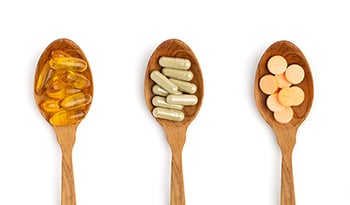有证据支持的十大营养补充剂
免责声明:本博客不提供诊断⋯

在种类繁多的膳食补充剂中,如何将真正优效、安心的补充剂与夸大其词的补充剂区分开来是一项挑战。面对优化健康、延寿的承诺,要如何辨别哪些营养补充剂有科学依据,哪些仅仅是时髦的流行趋势?我们将在本文中讨论那些有强有力科学证据支持的营养补充剂。
肌酸
肌酸是一种由氨基酸L-精氨酸、甘氨酸和L-蛋氨酸组成的化合物。它在能量代谢、肌肉表现和修复中起着至关重要的作用。肌酸还可用于在训练中提高高强度运动能力并增加瘦体重(而不是脂肪)。人们一开始对肌酸安心性的担忧已被推翻。研究发现,肌酸不会导致脱发或尿酸水平升高,不会对健康人的肾脏造成损害,也不会引起脱水或肌肉痉挛。
新的证据表明,补充肌酸能增加肌肉和大脑的肌酸储存。这在压力时期(例如睡眠中断和衰老时期)尤其重要,因为压力会导致大脑肌酸水平降低。2022年的一项荟萃分析(一项综合多项研究结果的研究)显示,补充肌酸可提高健康人的记忆力,尤其是老年人(66至76岁)。
肌酸的服用剂量通常为每天5毫克一水肌酸。粉末状肌酸在冷水和室温水中的溶解度较低,因此需要与温水混合。
蛋白质粉
肌肉力量越强,各种原因导致的死亡率就越低,因此,在年轻时特大限度地加强肌肉力量,在中年时保持肌肉力量,在老年时尽量减少肌肉流失,这一点非常重要。营养和运动训练可以减缓或逆转肌肉衰弱、功能障碍和残疾,因此医学指南建议我们增加蛋白质的摄入量。
一些研究报告称,低蛋白饮食的小鼠寿命更长,因此有一些人建议采用低蛋白饮食来延寿。然而,这种说法并没有在人类身上得到证实。我们需要保持肌肉力量,以便在衰老过程中保持独立性和抵御疾病的能力。此外,2020年的一项研究报告显示,总蛋白质摄入量越高,全因死亡率越低,从而支持了科学研究推荐的每天每公斤体重摄入1.6-2.2克膳食蛋白质能给人体带来益处。需要注意的是,摄入量高于每天每公斤体重1.62克的时候,蛋白质不会进一步促进阻力训练引起的肌肉质量增加。老年人的蛋白质摄入量应达到每天每公斤体重2克(即体重80公斤的人摄入160克蛋白质)。较高的蛋白质摄入量可帮助老年人弥补肌肉的损失,而且他们的消化道对蛋白质的吸收不如年轻人。
国际运动营养学会建议,一天中应进食多餐蛋白质,每餐间隔3-4小时。蛋白质粉中的蛋白质生物利用率很高,而且蛋白质粉极好不要添加盐和糖,可以将其混合进冰沙和奶昔中服用。
三甲基甘氨酸(TMG或甜菜碱)
TMG有助于加速三磷酸腺苷(ATP,细胞的能量货币)的循环。这样可以促进肌肉蛋白质的合成,并通过在高强度活动中避免疲劳来提高运动表现。
在2017年的一项系统性综述表示,TMG补充剂只有在与运动训练相结合时才能增加力量和爆发力。事实上,TMG在与高强度力量/爆发力运动结合时可能极其优效,因此TMG可能在高代谢需求的训练环境中发挥上佳效果。例如,TMG可提高专业青少年足球运动员的特大氧排量(有氧体能)和重复冲刺能力。相比之下,无论是否补充肌酸,补充TMG都不会影响未经训练的个体的力量和爆发力表现。
同型半胱氨酸是一种氨基酸,当其在血液中的含量升高时,罹患阿尔茨海默病的风险会增加。因此,降低血液中的高同型半胱氨酸水平是极有希望帮助预防阿尔茨海默病的干预措施之一。TMG可能降低血液中的同型半胱氨酸水平。关于TMG对痴呆症发病率的影响,还需要进行更多的研究,但鉴于目前对其益处的了解,TMG的剂量通常为每天500毫克至1克。
维生素和矿物质
一项研究报告显示,31% 的美国人面临至少一种维生素缺乏或贫血的风险。人们通常很难仅靠饮食来达到建议的每日微量营养素摄入量,尤其是维生素B3、维生素D3、维生素K2、锌和镁。极近的一项大型研究表明,连续三年每天补充多种维生素和矿物质可能优化老年人的整体认知能力。大多数多种维生素补充剂都大大超出了建议的每日摄入量,但在选择多种维生素或矿物质补充剂时,应选择避免“超大剂量”的补充剂,其配方应能补充健康饮食。
Omega-3
Omega-3脂肪酸主要有三种:α-亚麻酸(ALA)、二十二碳六烯酸(DHA)和二十碳五烯酸(EPA)。ALA是一种必需脂肪酸(人体无法制造),因此必须从食物和饮品中获取。人体会将少量的ALA转化为EPA和DHA,但从食物或膳食补充剂中获取这两种海洋欧米伽-3 脂肪酸是提高它们在体内含量的仅有方法。EPA和DHA存在于鱼油、磷虾油、鱼肝油和含有藻油的素食产品中。
研究一致表明,与不吃鱼的人相比,经常吃鱼的人认知能力下降的情况明显减少。这些发现催生了一种假设,即Omega-3海洋油补充剂可以缓解认知能力下降,但目前这种假说还缺乏随机对照试验的证据支持。例如,对于认知能力健康的老年人、患有老年性黄斑变性眼疾的老年人,甚至轻度/中度阿尔茨海默病患者来说,每天补充Omega-3并不能优化他们的认知能力。这些发现与多项荟萃分析结果一致,即与安慰剂相比,补充Omega-3不会影响健康老年人或阿尔茨海默病患者的认知功能。
补充Omega-3的好处可能仅针对那些不经常在饮食中食用高脂肪鱼类的人。在一项对25000多人进行的研究中,每天补充1克Omega-3有将心脏病发作的风险降低28%。梅奥诊所的一项荟萃分析也支持这一结论,该分析表明,补充Omega-3可显著降低心脏病发作的风险。美国心脏协会认为,配方高剂量(每天4克)Omega-3脂肪酸可优效、安心地帮助降低甘油三酯水平。
影响Omega-3补充剂效果的因素包括DHA和EPA的剂量、EPA与DHA的比例、EPA和DHA的基线状态、方方剂使用、健康状况以及其他营养素的摄入量。Omega-3补充剂通常以乙醚胶囊或瓶装液体的形式出现,它们的化学形式是甘油三酯或乙酯。当补充剂与含有其他脂肪的膳食一起服用时,当服用甘油三酯形式而不是乙酯形式时,以及当它没有“肠溶衣”时,油的吸收程度会增加。通常可以每天服用1-2粒胶囊或5毫升液体的Omega-3补充剂。
洋车前子壳
洋车前子壳对我们的肠道细菌非常重要,它是可溶性纤维的主要来源。洋车前子壳可能有助于调节血糖水平,软化和增加粪便体积,增加饱腹感,并有助于轻体。纤维摄入量越高,总胆固醇和低密度脂蛋白(LDL)胆固醇就越低。此外,洋车前子壳可能对控制血压高也很优效。与洋车前子壳补充剂有关的一个安心问题是铅污染,因为接触这种重金属会对肝脏、肾脏、神经系统和心血管系统产生不利影响。因此,选择经过第三方全度和重金属含量检测的品牌至关重要。
洋车前子壳补充剂通常以粉末或胶囊的形式存在。洋车前子壳粉可以混合入冰沙或奶昔中。比较好的做法是从低剂量开始(如半茶匙壳粉),逐渐增加剂量至每天1-2茶匙(5-10克)。要确保在服用洋车前子补充剂时搭配大量液体(极好是水),这一点很重要。
胶原蛋白
胶原蛋白是我们身体中含量尤为丰富的一种蛋白质。氨基酸是蛋白质的组成成分,而胶原蛋白肽是氨基酸的短链。因此,关于胶原蛋白肽补充剂是否能在足够的蛋白质摄入量之外带来额外的益处,还存在很多争议。一项随机、双盲、安慰剂对照试验显示,胶原蛋白补充剂可消减约8%的皱纹。
在2020年的一项随机双盲医学试验中,比较了36克水解牛胶原蛋白和35克大豆蛋白对男性烧伤患者伤口愈合的影响,与大豆蛋白相比,使用补充水解胶原蛋白后伤口愈合率明显提高。(大豆蛋白的生物利用率高,对男性体内的动情素或睾酮水平没有影响,因此大豆蛋白是一个很好的比较对象)。此外,2023年的一项荟萃分析发现,有充分证据表明水解胶原蛋白能优化皮肤的水合作用和弹性。
除了满足日常蛋白质摄入目标外,胶原蛋白肽补充剂的剂量通常为每天10-15克。
透明质酸(玻尿酸)
透明质酸是一种天然存在于人体中的物质,它在皮肤、关节和眼睛中含量较高。透明质酸具有独特的保水功能,有助于保持组织湿润和润滑。虽然人体50%的透明质酸存在于皮肤中,但随着年龄的增长,皮肤中透明质酸的含量会逐渐减少。几项精心设计的人体试验表明,口服透明质酸补充剂可优化皮肤的水合作用、色泽、厚度、弹性、紧雅度、光泽和柔软度,同时减少皮肤皱纹,防止皮肤脱水。
有人担心透明质酸与恶性细胞变异有关,但给已经患癌的小鼠服用透明质酸后,并没有产生有害影响。持续至少12个月的人体试验也显示没有安心问题。
当我们摄入高分子量的口服透明质酸时,肠道细菌会将其分解成较短的低分子量片段。尽管透明质酸的生物利用度因分子量而异,但高分子量和低分子量的透明质酸都能控制皮肤皱纹,优化皮肤光泽和柔软。虽然还需要更多的研究,但目前的文献表明,营养补充剂中透明质酸的分子量不太可能对其功效产生影响。人体试验中透明质酸的剂量范围为每天80毫克至200毫克。
低剂量褪黑素
褪黑素是由大脑中的松果体分泌的一种荷尔蒙。 当天黑时,松果体开始分泌褪黑素,而光线则使其停止分泌。褪黑素有助于控制人体的昼夜节律,让我们晚上困倦,白天清醒。这使我们能够入睡,并获得良好的夜间休息。研究表明,褪黑素可以帮助人们更快入睡,并提高睡眠质量,但对于服用多少褪黑素以及何时服用尚存疑虑。
作为一种“时间生物剂”,褪黑素可以改变我们的睡眠-觉醒周期。目前的研究支持在入睡前1-2小时服用褪黑素补充剂,以获得上佳效果。相比之下,在夜间人体褪黑素水平已经很高时服用褪黑素补充剂则没有任何效果。我们的身体每晚会制造10-80微克的褪黑素,但服用褪黑素补充剂的人通常服用的剂量要比这高得多。不过,还需要更多的研究来确定高剂量服用的长期效果,因此建议每天服用褪黑素的剂量极好不要超过300微克。此外,在这个领域的研究还在活跃地进行中,目前还没有强有力的证据表明补充褪黑素会降低死亡率或减少心脏病。
关于衰老需要考虑的一个重要方面是,褪黑素除了对睡眠有影响外,还具有抗氧和缓解炎性反应作用。随着年龄的增长,体内褪黑素的分泌量会减少10倍,而褪黑素分泌量的减少会加剧衰老过程。这可能会形成一个恶性循环——随着年龄的增长,褪黑素减少,炎性反应加剧,从而进一步减少人体产生的褪黑素分泌量。因此,为了使褪黑素水平修复到更年轻的状态,老年人应考虑在入睡前1-2小时服用低剂量、长效缓释型褪黑素补充剂。
N-乙酰半胱氨酸(NAC)
NAC是一种衍生自氨基酸L-半胱氨酸的化合物。随着年龄的增长,为了维持生存,活性氧类(氧化剂)会增加。但是,它们终究会累积起来,并加重而不是减轻与年龄有关的损伤。保持氧化剂和抗氧剂之间的平衡非常重要,但从我们迈入45岁开始,一种名为谷胱甘肽的优效抗氧剂就迅速减少。因此,建议通过补充谷胱甘肽的组成成分来修复氧化剂和抗氧剂之间的平衡。谷胱甘肽的组成成分包括甘氨酸、半胱氨酸和谷氨酸。
与此列表中的其他补充剂不同,NAC研究仍处于早期阶段。不过,2022年的一项随机、双盲、安慰剂对照试验显示,老年人补充甘氨酸和NAC(GlyNAC)可能让谷胱甘肽缺乏症好转,减少氧化应激,优化线粒体功能障碍。鉴于胶原蛋白和TMG补充剂(前文已述)含有甘氨酸,服用胶原蛋白或甘氨酸的人可以考虑从45岁开始每天只添加1克NAC。
结语
补充剂可能可以弥补特定营养素的不足,解决特定的健康问题,或以某种方式优化身体结构/功能。不过,建议在使用营养补充剂之前,尽量从高质量的膳食中摄取营养。此外,使用补充剂必须谨慎,确保其对人体安心。
根据你的健康状况、目前的方方剂和健康目标,咨询合适的医学健康专业人员可以帮助你确定适合你个人需求的补充剂。上述营养补充剂显示出了良好的应用前景,但在大多数情况下,我们还需要更多的随机对照试验来确定它们所有的益处、上佳剂量、上佳服用时间和禁忌症。
参考资料:
- Kreider RB, Kalman DS, Antonio J, Ziegenfuss TN, Wildman R, Collins R, et al. International Society of Sports Nutrition position stand: safety and efficacy of creatine supplementation in exercise, sport, and medicine. Journal of the International Society of Sports Nutrition. 2017 Jan 3;14(1):18.
- De Moraes R, Van Bavel D, De Moraes BS, Tibiriçá E. Effects of dietary creatine supplementation on systemic microvascular density and reactivity in healthy young adults. Nutr J. 2014 Dec;13(1):115.
- Forbes SC, Cordingley DM, Cornish SM, Gualano B, Roschel H, Ostojic SM, et al. Effects of Creatine Supplementation on Brain Function and Health. Nutrients. 2022 Feb 22;14(5):921.
- Antonio J, Candow DG, Forbes SC, Gualano B, Jagim AR, Kreider RB, et al. Common questions and misconceptions about creatine supplementation: what does the scientific evidence really show? Journal of the International Society of Sports Nutrition. 2021 Jan 2;18(1):13.
- Cruz-Jentoft AJ, Bahat G, Bauer J, Boirie Y, Bruyère O, Cederholm T, et al. Sarcopenia: revised European consensus on definition and diagnosis. Age and Ageing. 2019 Jan 1;48(1):16–31.
- Bloom I, Shand C, Cooper C, Robinson S, Baird J. Diet Quality and Sarcopenia in Older Adults: A Systematic Review. Nutrients. 2018 Mar 5;10(3):308.
- Solon-Biet SM, McMahon AC, Ballard JWO, Ruohonen K, Wu LE, Cogger VC, et al. The Ratio of Macronutrients, Not Caloric Intake, Dictates Cardiometabolic Health, Aging, and Longevity in Ad Libitum-Fed Mice. Cell Metabolism. 2014 Mar;19(3):418–30.
- Naghshi S, Sadeghi O, Willett WC, Esmaillzadeh A. Dietary intake of total, animal, and plant proteins and risk of all cause, cardiovascular, and cancer mortality: systematic review and dose-response meta-analysis of prospective cohort studies. BMJ. 2020 Jul 22;m2412.
- Morton RW, Murphy KT, McKellar SR, Schoenfeld BJ, Henselmans M, Helms E, et al. A systematic review, meta-analysis and meta-regression of the effect of protein supplementation on resistance training-induced gains in muscle mass and strength in healthy adults. Br J Sports Med. 2018 Mar;52(6):376–84.
- Jäger R, Kerksick CM, Campbell BI, Cribb PJ, Wells SD, Skwiat TM, et al. International Society of Sports Nutrition Position Stand: protein and exercise. Journal of the International Society of Sports Nutrition. 2017 Jan 3;14(1):20.
- Baraki, Austin, Feigenbaum, Jordan, Sullivan, Jonathon. Practical guidelines for implementing a strength training program for adults [Internet]. Wolters Kluwer; 2023. Available from: https://www.uptodate.com/contents/practical-guidelines-for-implementing-a-strength-training-program-for-adults
- Volaklis KA, Halle M, Meisinger C. Muscular strength as a strong predictor of mortality: A narrative review. European Journal of Internal Medicine. 2015 Jun;26(5):303–10.
- Sargeant AJ. Structural and functional determinants of human muscle power. Experimental Physiology. 2007 Mar;92(2):323–31.
- Ismaeel A. Effects of Betaine Supplementation on Muscle Strength and Power: A Systematic Review. Journal of Strength and Conditioning Research. 2017 Aug;31(8):2338–46.
- Lee EC, Maresh CM, Kraemer WJ, Yamamoto LM, Hatfield DL, Bailey BL, et al. Ergogenic effects of betaine supplementation on strength and power performance. Journal of the International Society of Sports Nutrition. 2010 Jan 5;7(1):27.
- Nobari H, Cholewa JM, Castillo-Rodríguez A, Kargarfard M, Pérez-Gómez J. Effects of chronic betaine supplementation on performance in professional young soccer players during a competitive season: a double blind, randomized, placebo-controlled trial. Journal of the International Society of Sports Nutrition. 2021 Jan 2;18(1):67.
- Del Favero S, Roschel H, Artioli G, Ugrinowitsch C, Tricoli V, Costa A, et al. Creatine but not betaine supplementation increases muscle phosphorylcreatine content and strength performance. Amino Acids. 2012 Jun;42(6):2299–305.
- Yu JT, Xu W, Tan CC, Andrieu S, Suckling J, Evangelou E, et al. Evidence-based prevention of Alzheimer's disease: systematic review and meta-analysis of 243 observational prospective studies and 153 randomised controlled trials. J Neurol Neurosurg Psychiatry. 2020 Nov;91(11):1201–9.
- Bird J, Murphy R, Ciappio E, McBurney M. Risk of Deficiency in Multiple Concurrent Micronutrients in Children and Adults in the United States. Nutrients. 2017 Jun 24;9(7):655.
- Baker LD, Manson JE, Rapp SR, Sesso HD, Gaussoin SA, Shumaker SA, et al. Effects of cocoa extract and a multivitamin on cognitive function: A randomized clinical trial. Alzheimer's & Dementia. 2023 Apr;19(4):1308–19.
- Singh P, Gollapalli K, Mangiola S, Schranner D, Yusuf MA, Chamoli M, et al. Taurine deficiency as a driver of aging. Science. 2023 Jun 9;380(6649):eabn9257.
- Van Gelder BM, Tijhuis M, Kalmijn S, Kromhout D. Fish consumption, n−3 fatty acids, and subsequent 5-y cognitive decline in elderly men: the Zutphen Elderly Study. The American Journal of Clinical Nutrition. 2007 Apr;85(4):1142–7.
- Dangour AD, Allen E, Elbourne D, Fasey N, Fletcher AE, Hardy P, et al. Effect of 2-y n−3 long-chain polyunsaturated fatty acid supplementation on cognitive function in older people: a randomized, double-blind, controlled trial. The American Journal of Clinical Nutrition. 2010 Jun;91(6):1725–32.
- Chew EY, Clemons TE, Agrón E, Launer LJ, Grodstein F, Bernstein PS. Effect of Omega-3 Fatty Acids, Lutein/Zeaxanthin, or Other Nutrient Supplementation on Cognitive Function: The AREDS2 Randomized Clinical Trial. JAMA. 2015 Aug 25;314(8):791.
- Freund-Levi Y, Eriksdotter-Jönhagen M, Cederholm T, Basun H, Faxén-Irving G, Garlind A, et al. ω-3 Fatty Acid Treatment in 174 Patients With Mild to Moderate Alzheimer Disease: OmegAD Study: A Randomized Double-blind Trial. Arch Neurol. 2006 Oct 1;63(10):1402.
- Jiao J, Li Q, Chu J, Zeng W, Yang M, Zhu S. Effect of n−3 PUFA supplementation on cognitive function throughout the life span from infancy to old age: a systematic review and meta-analysis of randomized controlled trials. The American Journal of Clinical Nutrition. 2014 Dec;100(6):1422–36.
- Manson JE, Cook NR, Lee IM, Christen W, Bassuk SS, Mora S, et al. Marine n−3 Fatty Acids and Prevention of Cardiovascular Disease and Cancer. N Engl J Med. 2019 Jan 3;380(1):23–32.
- Bernasconi AA, Wiest MM, Lavie CJ, Milani RV, Laukkanen JA. Effect of Omega-3 Dosage on Cardiovascular Outcomes. Mayo Clinic Proceedings. 2021 Feb;96(2):304–13.
- Skulas-Ray AC, Wilson PWF, Harris WS, Brinton EA, Kris-Etherton PM, Richter CK, et al. Omega-3 Fatty Acids for the Management of Hypertriglyceridemia: A Science Advisory From the American Heart Association. Circulation [Internet]. 2019 Sep 17 [cited 2024 Mar 2];140(12). Available from: https://www.ahajournals.org/doi/10.1161/CIR.0000000000000709
- Office of Dietary Supplements - Omega-3 Fatty Acids [Internet]. [cited 2024 Mar 3]. Available from: https://ods.od.nih.gov/factsheets/Omega3FattyAcids-Consumer/
- Troesch B, Eggersdorfer M, Laviano A, Rolland Y, Smith AD, Warnke I, et al. Expert Opinion on Benefits of Long-Chain Omega-3 Fatty Acids (DHA and EPA) in Aging and Clinical Nutrition. Nutrients. 2020 Aug 24;12(9):2555.
- Hartley L, May MD, Loveman E, Colquitt JL, Rees K. Dietary fibre for the primary prevention of cardiovascular disease. Cochrane Heart Group, editor. Cochrane Database of Systematic Reviews [Internet]. 2016 Jan 7 [cited 2024 Feb 28];2016(2). Available from: http://doi.wiley.com/10.1002/14651858.CD011472.pub2
- Brum JM, Gibb RD, Peters JC, Mattes RD. Satiety effects of psyllium in healthy volunteers. Appetite. 2016 Oct;105:27–36.
- Lambeau KV, McRorie JW. Fiber supplements and clinically proven health benefits: How to recognize and recommend an effective fiber therapy. Journal of the American Association of Nurse Practitioners. 2017 Apr;29(4):216–23.
- Clark CCT, Salek M, Aghabagheri E, Jafarnejad S. The effect of psyllium supplementation on blood pressure: a systematic review and meta-analysis of randomized controlled trials. Korean J Intern Med. 2020 Nov 1;35(6):1385–99.
- Kumar A, Kumar A, M.M.S. CP, Chaturvedi AK, Shabnam AA, Subrahmanyam G, et al. Lead Toxicity: Health Hazards, Influence on Food Chain, and Sustainable Remediation Approaches. IJERPH. 2020 Mar 25;17(7):2179.
- Kim J, Lee SG, Lee J, Choi S, Suk J, Lee JH, et al. Oral Supplementation of Low-Molecular-Weight Collagen Peptides Reduces Skin Wrinkles and Improves Biophysical Properties of Skin: A Randomized, Double-Blinded, Placebo-Controlled Study. Journal of Medicinal Food. 2022 Dec 1;25(12):1146–54.
- Bagheri Miyab K, Alipoor E, Vaghardoost R, Saberi Isfeedvajani M, Yaseri M, Djafarian K, et al. The effect of a hydrolyzed collagen-based supplement on wound healing in patients with burn: A randomized double-blind pilot clinical trial. Burns. 2020 Feb;46(1):156–63.
- Reed KE, Camargo J, Hamilton-Reeves J, Kurzer M, Messina M. Neither soy nor isoflavone intake affects male reproductive hormones: An expanded and updated meta-analysis of clinical studies. Reproductive Toxicology. 2021 Mar;100:60–7.
- Pu SY, Huang YL, Pu CM, Kang YN, Hoang KD, Chen KH, et al. Effects of Oral Collagen for Skin Anti-Aging: A Systematic Review and Meta-Analysis. Nutrients. 2023 Apr 26;15(9):2080.
- Gao Y, Wang R, Zhang L, Fan Y, Luan J, Liu Z, et al. Oral administration of hyaluronic acid to improve skin conditions via a randomized double‐blind clinical test. Skin Research and Technology. 2023 Nov;29(11):e13531.
- Hsu TF, Su ZR, Hsieh YH, Wang MF, Oe M, Matsuoka R, et al. Oral Hyaluronan Relieves Wrinkles and Improves Dry Skin: A 12-Week Double-Blinded, Placebo-Controlled Study. Nutrients. 2021 Jun 28;13(7):2220.
- Laurent TC, Fraser JR. Hyaluronan. FASEB J. 1992 Apr;6(7):2397–404.
- Oe M, Sakai S, Yoshida H, Okado N, Kaneda H, Masuda Y, et al. Oral hyaluronan relieves wrinkles: a double-blinded, placebo-controlled study over a 12-week period. CCID. 2017 Jul;Volume 10:267–73.
- Michelotti A, Cestone E, De Ponti I, Pisati M, Sparta E, Tursi F. Oral intake of a new full-spectrum hyaluronan improves skin profilometry and ageing: a randomized, double-blind, placebo-controlled clinical trial. European Journal of Dermatology. 2021 Dec;31(6):798–805.
- Seino S, Takeshita F, Asari A, Masuda Y, Kunou M, Ochiya T. No Influence of Exogenous Hyaluronan on the Behavior of Human Cancer Cells or Endothelial Cell Capillary Formation. Journal of Food Science [Internet]. 2014 Jul [cited 2024 Feb 28];79(7). Available from: https://ift.onlinelibrary.wiley.com/doi/10.1111/1750-3841.12500
- Oe M, Mitsugi K, Odanaka W, Yoshida H, Matsuoka R, Seino S, et al. Dietary Hyaluronic Acid Migrates into the Skin of Rats. The Scientific World Journal. 2014;2014:1–8.
- Cyphert JM, Trempus CS, Garantziotis S. Size Matters: Molecular Weight Specificity of Hyaluronan Effects in Cell Biology. International Journal of Cell Biology. 2015;2015:1–8.
- Tashiro T, Seino S, Sato T, Matsuoka R, Masuda Y, Fukui N. Oral Administration of Polymer Hyaluronic Acid Alleviates Symptoms of Knee Osteoarthritis: A Double-Blind, Placebo-Controlled Study over a 12-Month Period. The Scientific World Journal. 2012;2012:1–8.
- Seithikurippu R AM. Melatonin, the Hormone of Darkness: From Sleep Promotion to Ebola Treatment. Brain Disord Ther [Internet]. 2015 [cited 2024 Feb 28];04(01). Available from: http://www.omicsgroup.org/journals/melatonin-the-hormone-of-darkness-from-sleep-promotion-to-ebola-treatment-2168-975X.1000151.php?aid=36189
- Low TL, Choo FN, Tan SM. The efficacy of melatonin and melatonin agonists in insomnia – An umbrella review. Journal of Psychiatric Research. 2020 Feb;121:10–23.
- Fatemeh G, Sajjad M, Niloufar R, Neda S, Leila S, Khadijeh M. Effect of melatonin supplementation on sleep quality: a systematic review and meta-analysis of randomized controlled trials. J Neurol. 2022 Jan;269(1):205–16.
- Peuhkuri K, Sihvola N, Korpela R. Dietary factors and fluctuating levels of melatonin. Food & Nutrition Research. 2012 Jan;56(1):17252.
- Hardeland R. Aging, Melatonin, and the Pro- and Anti-Inflammatory Networks. IJMS. 2019 Mar 11;20(5):1223.
- Melhuish Beaupre LM, Brown GM, Gonçalves VF, Kennedy JL. Melatonin's neuroprotective role in mitochondria and its potential as a biomarker in aging, cognition and psychiatric disorders. Transl Psychiatry. 2021 Jun 2;11(1):339.
- Hekimi S, Lapointe J, Wen Y. Taking a "good" look at free radicals in the aging process. Trends in Cell Biology. 2011 Oct;21(10):569–76.
- Richie JP, Nichenametla S, Neidig W, Calcagnotto A, Haley JS, Schell TD, et al. Randomized controlled trial of oral glutathione supplementation on body stores of glutathione. Eur J Nutr. 2015 Mar;54(2):251–63.
- Jones DP, Mody VC, Carlson JL, Lynn MJ, Sternberg P. Redox analysis of human plasma allows separation of pro-oxidant events of aging from decline in antioxidant defenses. Free Radical Biology and Medicine. 2002 Nov;33(9):1290–300.
- Kumar P, Liu C, Suliburk J, Hsu JW, Muthupillai R, Jahoor F, et al. Supplementing Glycine and N-Acetylcysteine (GlyNAC) in Older Adults Improves Glutathione Deficiency, Oxidative Stress, Mitochondrial Dysfunction, Inflammation, Physical Function, and Aging Hallmarks: A Randomized Clinical Trial. Lipsitz LA, editor. The Journals of Gerontology: Series A. 2023 Jan 26;78(1):75–89.

 作者 Brad Stanfield 博士,M.D.
作者 Brad Stanfield 博士,M.D.


